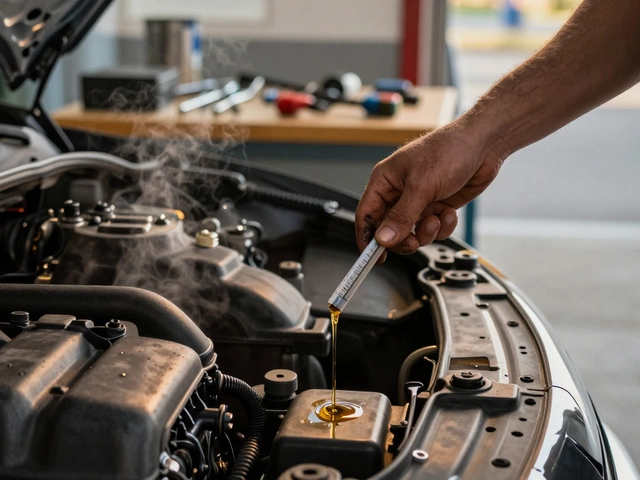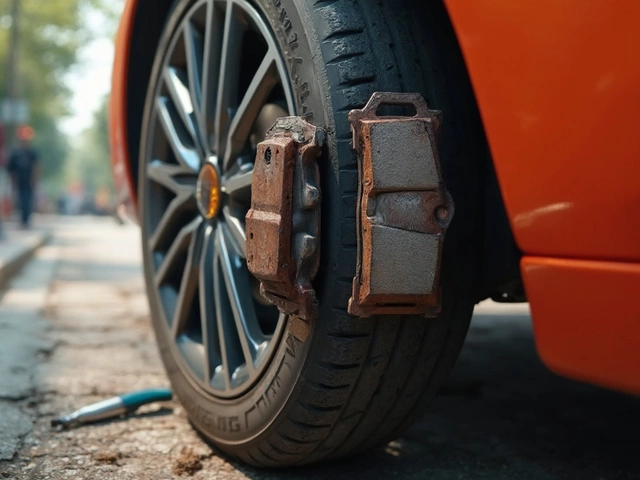If you're just looking for a number, most cars can go somewhere between 30,000 and 100,000 miles without new spark plugs. The huge range throws people off—not all cars or plugs are built the same. Some older cars and copper plugs barely make it past 30,000 miles before throwing a fit. Newer cars with iridium or platinum spark plugs can cruise up to 100,000 miles if you're lucky.
But here's the catch: just because your owner's manual claims '100,000 miles' doesn't mean you're actually in the clear that whole time. Plug condition can tank faster with lots of short trips, stop-and-go driving, or if your engine burns oil. Waiting too long can make your car run rough, kill your gas mileage, and even leave you stranded. Changing spark plugs on time is one of those cheap jobs that saves a fortune later.
- What Do Spark Plugs Actually Do?
- How Many Miles Can You Go Without Changing Spark Plugs?
- Signs Your Spark Plugs Need Replacing
- What Happens If You Skip Spark Plug Changes?
- Modern vs Older Cars: Why It Matters
- Easy Tips for Spark Plug Maintenance
What Do Spark Plugs Actually Do?
Without spark plugs, your car simply won’t start. They’re the tiny but tough parts that sit in the engine and create the spark needed to ignite fuel. Every time you turn your key or push the start button, your spark plugs light up the air-fuel mix inside each cylinder, kicking your engine into action. No spark? No go. It’s that simple.
Here’s what happens, step by step, every time your engine fires:
- The piston moves up and compresses the air-fuel mix inside the cylinder.
- The spark plug gets a jolt of electricity—around 12,000 to 45,000 volts.
- This jolt jumps the tiny gap at the tip of the spark plug, creating a hot spark.
- The spark ignites the compressed fuel mix, pushing the piston down—which spins your engine.
Imagine doing this hundreds of times a minute—actually, in a typical four-cylinder car idling at 800 RPM, that’s 1,600 sparks every single minute! Now multiply that by all your daily driving.
It’s not just about firing up your engine, either. Good spark plugs make sure fuel burns efficiently, so you use less gas, pollute less, and get smoother power. Bad spark plugs can mean poor starts, rough idling, and failed emissions tests.
| Spark Plug Fact | Data/Detail |
|---|---|
| Voltage Needed for Spark | 12,000 – 45,000 volts |
| Sparks per Minute (4-cylinder, idle) | 1,600 sparks |
| Typical Lifespan | 30,000 – 100,000 miles |
| Ignition Timing Accuracy | Milliseconds matter for power & mpg |
So, if you’re wondering why your car acts weird or just drinks more gas than usual, don’t ignore those spark plugs. They do way more work than most people think, and when they’re off, your whole engine pays the price.
How Many Miles Can You Go Without Changing Spark Plugs?
This is one of those car questions with an answer that’s always, “It depends.” Back in the day, copper spark plugs needed swapping out every 20,000 to 30,000 miles. Now, with iridium and platinum plugs, some folks don’t touch them for 60,000, 80,000, or even 100,000 miles. That said, playing the waiting game isn’t always smart. One survey by CarMD in 2023 found that Americans most commonly replaced spark plugs around 65,000 miles, regardless of what their manual said.
"It’s not just about mileage—driving habits, climate, and even the quality of fuel can speed up spark plug wear," says Michael Calkins from AAA.
Here’s a quick glance at typical spark plug lifespans depending on type:
| Spark Plug Type | Average Lifespan (miles) |
|---|---|
| Copper | 20,000 – 40,000 |
| Platinum | 50,000 – 60,000 |
| Iridium | 80,000 – 100,000 |
But just because iridium plugs are tough doesn’t mean you should ignore them. Engines running rich, lots of short trips, or hard starts in cold weather can all eat away at lifespan. Plus, some high-performance cars still run through plugs faster due to hotter operating temps.
If your car is used mostly for city driving, with lots of starts and stops, don’t bank on hitting those high mileage numbers. Check your owner’s manual, but also pay attention to how your engine feels and sounds. If you want to stretch it close to the limit, get the plugs checked around 60,000 miles. Avoiding spark plug trouble isn’t just about following a number—it’s about knowing your own driving style and listening to your car.
The main thing to remember? If you care about spark plugs, you’re already ahead of most folks. Stick with what works for your car, and you’ll avoid headaches (and towing bills) later on.
Signs Your Spark Plugs Need Replacing
Spark plugs don’t just quit overnight. Usually, they send off a bunch of warning signs first, and knowing these makes a big difference. Ignoring them means you’ll end up with lousy performance or even get stranded.
- Engine Misfires: The most common sign. If your engine suddenly starts shaking or coughing, especially when you accelerate, bad spark plugs are a likely culprit.
- Hard Starts: Struggling to get the engine going on the first try? That slow cranking or repeated turning of the key could mean your spark plugs aren’t firing right.
- Rough Idle: If your engine sounds rough, jittery, or feels like it's vibrating when stopped, old plugs could be to blame.
- Drop in Gas Mileage: Noticing you’re at the pump more often? Worn spark plugs make your engine work harder, so you burn more fuel.
- Sluggish Acceleration: If your car hesitates or feels lazy when you step on the gas, your spark plugs might be toast.
People often ignore these signs until things go off the rails. Waiting too long not only makes driving less fun, but can also mess up your catalytic converter and cost you serious cash.
| Symptom | Possible Cause |
|---|---|
| Engine misfires | Worn out or fouled spark plugs |
| Hard starting | Weak or dirty spark plugs |
| Rough idle | Damaged spark plug or poor gap |
| Poor fuel economy | Aging or improperly gapped spark plugs |
| Slow acceleration | Failing spark plug igniting weakly |
If you spot any of this stuff, it’s way better (and cheaper) to swap your spark plugs sooner than later. Catching the problem early keeps your engine happy and saves you headaches down the road.

What Happens If You Skip Spark Plug Changes?
If you let your spark plugs go way past their prime, your car will start sending not-so-subtle signals that it's unhappy. You could get rough starts, annoying misfires, sluggish acceleration, and a big drop in gas mileage. Eventually, the engine could even fail to start at all. That's not just annoying—it can get expensive.
Skipping spark plug changes wears down your ignition system way faster. When spark plugs can't fire the way they're supposed to, your ignition coils and wires have to work harder. They heat up, burn out, and then, you've suddenly got a stack of repair bills. And here's the kicker: one dead spark plug can mess up your catalytic converter—a fix that can cost $1,000 or more.
Here’s a quick rundown of what you risk when you avoid changing spark plugs:
- Poor engine performance (jerky driving and stalling)
- Lower fuel economy (spending more at the pump)
- Harder cold starts or no start at all
- More emissions (could fail a smog test)
- Potential engine and catalytic converter damage
Check out this table for how old spark plugs can hit your car’s performance:
| Consequence | Extra Cost/Problem |
|---|---|
| Lower MPG | Up to 30% more fuel used |
| Misfires | Engine shakes, emissions jump |
| Hard Starts | Can leave you stranded |
| Ignition Damage | New coils/wires: $300-$600 |
| Catalytic Converter Failure | $1,000+ to fix |
Long story short: ignoring spark plugs turns a quick $50 maintenance job into a nightmare. If your car starts acting weird, don't wait until you're stuck on the shoulder. Make spark plug checks a habit and you'll dodge a world of headaches.
Modern vs Older Cars: Why It Matters
When it comes to spark plugs, your car’s age makes a huge difference in how long you can go between changes. Technology has moved the goalposts, and knowing your car's setup stops you from wasting money or getting stranded.
Older cars—let’s say anything built before the early 2000s—usually come with standard copper spark plugs. These do their job, but they wear out fast. You’re looking at swap intervals of about 30,000 to 50,000 miles. If you ignore that, misfires, rough idles, and poor starts become annoyances you can’t shake off.
Modern cars tell a different story. Most automakers started fitting newer engines with platinum or iridium spark plugs. These plug types are way tougher—some last up to 100,000 miles under normal driving. Newer engines also have better ignition systems and onboard sensors that keep the spark strong for longer stretches. But it doesn't mean you get a free pass forever. Wear still happens, just not as quickly.
Here’s how different plugs usually stack up:
| Spark Plug Type | Typical Lifespan (Miles) | Common Car Era |
|---|---|---|
| Copper | 30,000-50,000 | Older (Pre-2000s) |
| Platinum | 60,000-100,000 | Modern (Early 2000s+) |
| Iridium | 80,000-120,000 | Late model (2010+) |
Keep in mind, those numbers are averages. If you drive a lot of short trips, live somewhere dusty, or your engine burns oil, your plugs might call it quits early.
The takeaway: always check what your owner’s manual says, but remember, even the best spark plugs don’t last forever. Newer cars make life easier, but skipping maintenance is still asking for trouble.
Easy Tips for Spark Plug Maintenance
Want to keep your engine running smooth and avoid surprise bills? Follow these simple tips and your spark plugs will thank you with fewer misfires and better gas mileage.
- Check the Owner’s Manual First: Every car has a different maintenance schedule. Your manual will tell you exactly when your spark plugs need attention. If you threw out the booklet, search the car maker’s site for a digital version.
- Visually Inspect the Plugs: Pull one out every oil change or at least once a year. Look for carbon buildup, oil fouling, or worn electrodes. White, tan, or gray insulators usually mean “all good.” Big cracks, oil-soaked tips, or heavy soot? Time for replacements.
- Use the Right Plug Type: Don’t just buy the cheapest plugs at the store, or you’ll be pulling them again way sooner. Stick with the type recommended by your car’s manufacturer (copper, platinum, or iridium). Some engines only work right with a certain style.
- Keep Plugs Torqued: Tighten them to the right specs. Too loose, and you risk misfires. Too tight, and you’ll strip the threads or crack the plug. Most shops use a $20 torque wrench everyone can get at a hardware store.
- Replace All Plugs at the Same Time: If one is bad, chances are the others aren’t far behind. Swapping them all at once saves tow-ride headaches later.
- Don’t Ignore Your Check Engine Light: Modern cars have sensors that spot misfires fast. If the light flashes or stays on, don’t wait—check those plugs right away.
Here’s a quick cheat sheet for average spark plug lifespans, depending on the material:
| Spark Plug Material | Average Lifespan (Miles) |
|---|---|
| Copper | 30,000 - 50,000 |
| Platinum | 60,000 - 100,000 |
| Iridium | 80,000 - 120,000 |
Short drives, lots of idling, or an engine that burns oil can shorten even iridium plug life. Clean engine air, regular maintenance, and good-quality fuel help your spark plugs go the distance. And when in doubt, it’s cheaper to change plugs early than risk engine repairs later.









Write a comment